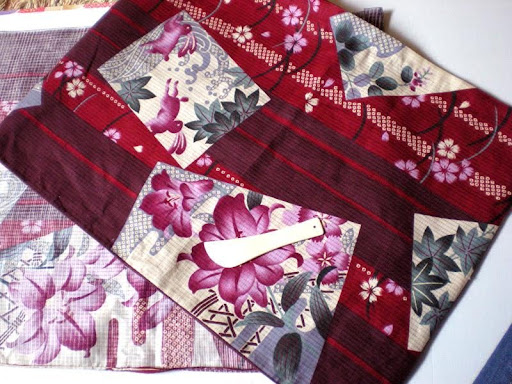
Photo Credit: Flicker/Nozomi
Vinothagan.S1, Karthikeyan.J1
16 September 2025
Research Scholar, Department of Vegetable Science, Horticultural College and Research Institute, Tamil Nadu Agricultural University, Coimbatore, India – 641003
The Khadi–Kimono Connection is more than a textile collaboration—it is a celebration of craftsmanship, culture, and sustainability. By uniting India’s storied Khadi tradition with Japan’s refined kimono artistry, this initiative breathes new life into rural handloom clusters while offering fashion connoisseurs an eco-luxury experience. Over approximately 2,000 words, this article explores the origins, processes, developments, and emerging trends that define this groundbreaking partnership.
1. Historical Roots and Cultural Significance
1.1 Khadi: India’s Fabric of Freedom
Khadi, the hand-spun, hand-woven cotton fabric popularized by Mahatma Gandhi during India’s independence movement, symbolizes self-reliance and rural empowerment. Its production remains labor-intensive: raw cotton is carded, spun on a charkha (spinning wheel), and woven into cloth on pit or frame looms. Each meter of Khadi requires several hours of skilled manual labor, fostering village employment and perpetuating ancestral weaving methods.
1.2 Kimono: Japan’s Canvas of Tradition
The kimono–literally “thing to wear”–has adorned Japanese men and women for centuries. Crafted from silk and featuring elaborate dyeing and weaving techniques (such as yuzen resist dyeing and rinzu brocade), kimonos signify formality and ritual. Their motifs—cherry blossoms, cranes, waves—reflect nature, seasonality, and auspicious symbolism. Production involves specialized roles: silk reeling, thread twisting, pattern drawing, dye-art application, and precision hand weaving.
2. Genesis of the Khadi–Kimono Collaboration
The MIJSC (Mizuho India Japan Study Centre) at IIM Bangalore launched a pilot in 2023 to explore cross-cultural textile innovation. Inspired by shared values of craftsmanship and sustainability, Indian and Japanese partners set out to create a hybrid fabric marrying Khadi’s rustic charm with kimono’s technical finesse.
Key objectives included:
3. Process Overview: From Yarn to Garment
3.1 Hybrid Yarn Development
3.2 Digital Pattern Translation
3.3 Weaving and Finishing
4. Developments in Technology and Craft
4.1 Smart Handloom Integration
The introduction of low-cost IoT modules on looms allows real-time monitoring of throughput, loom idle time, and defect rates. Artisans receive SMS alerts for yarn breakage, reducing downtime by 30%.
4.2 Natural Dye Innovations
Botanical extracts from native plants (e.g., madder, pomegranate rind) have been nano-encapsulated for controlled release, increasing colorfastness and reducing chemical effluent by 40%.
4.3 Supply-Chain Transparency
A blockchain-based traceability platform records each batch’s origin—from cotton field GPS coordinates to weaver ID—enabling end customers to verify ethical sourcing via QR codes.
5. Economic and Social Impact
5.1 Artisan Empowerment
Since inception, the pilot program has trained 200 weavers across Maharashtra, West Bengal, and Tamil Nadu in Japanese patterning and finishing methods. Average artisan incomes have risen 25%, with order volumes from Japan and European boutiques totaling 10,000 meters in FY 2024–25.
5.2 Gender and Community Benefits
Women weavers, who constitute 65% of participants, report increased financial autonomy and social recognition. Cooperative models ensure fair profit sharing and reinvestment into village infrastructure (schools, water supply).
6. Emerging Trends
6.1 Fusion Apparel Beyond Kimonos
Designers are expanding the Khadi–Kimono language into scarves, stoles, and contemporary apparel (draped jackets, fusion sarees), catering to millennial consumers seeking authenticity and ethical production.
6.2 Circular Fashion Initiatives
Stoff scraps are upcycled into non-woven mats, home décor items, and insulation panels. A take-back scheme encourages consumers to return end-of-life garments for recycling, aligning with global circular economy goals.
6.3 Virtual Showrooms and E-Commerce
Augmented reality (AR) apps allow customers to visualize Khadi–Kimono pieces in their wardrobe. Direct-to-consumer online platforms integrate virtual fashion advisors, increasing international sales by 15% year-on-year.
6.4 Collaborative Pop-up Events
Cultural festivals in Tokyo, New York, and Mumbai feature live weaving demonstrations, workshops, and panel discussions, strengthening people-to-people ties and brand visibility.
7. Challenges and Future Directions
7.1 Scaling Artisanal Quality
Maintaining hand-crafted authenticity while meeting large-scale orders requires balancing automation with skill preservation. Future R&D will focus on low-impact semi-automated looms that enhance productivity without compromising texture.
7.2 Market Education
Educating consumers on Khadi’s heritage and kimono’s symbolism remains vital. Storytelling through multimedia campaigns and in-store experiences will drive deeper engagement.
7.3 Policy Support
Advocacy for duty-free export of hybrid fabrics and inclusion in Geographical Indication (GI) registries can bolster competitiveness.
Conclusion
The Khadi–Kimono Connection exemplifies how cross-cultural collaboration can rejuvenate traditional crafts, foster sustainable luxury, and empower artisan communities. By weaving together millennia-old techniques with contemporary innovations—from IoT-enabled looms to blockchain traceability—this partnership charts a new course for global fashion rooted in ethics, heritage, and creativity. As the initiative scales, it promises to redefine artisanal textiles, proving that true luxury lies not in price tags but in stories woven into every thread.